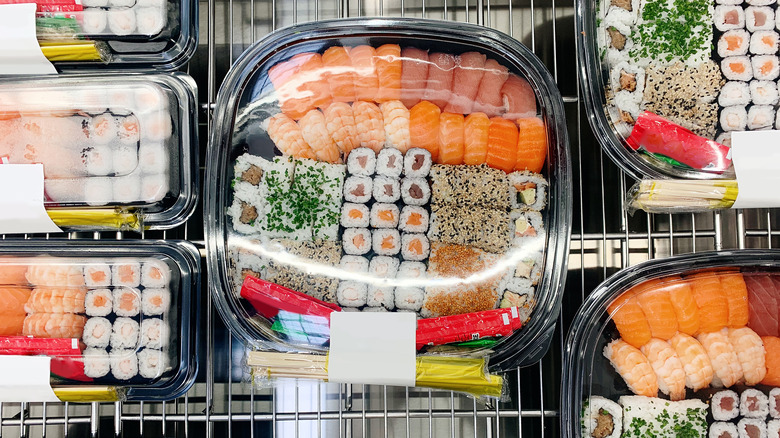Is It Dangerous To Eat Leftover Sushi?
We've all over-ordered sushi. There are the rolls, the sashimi, the nigiri — it's all delicious and addictive. But for as much as we love sushi, our wallets don't, so saving the leftovers to enjoy later is tempting, but can you? The answer is yes, but there are certain conditions where raw fish becomes dangerous. Shellfish and raw fish can be contaminated with parasites and bacteria, including Salmonella. The FDA cautions that eating raw fish and seafood can increase the chances of foodborne illnesses. Properly prepared sushi, however, is usually perfectly safe. With specific storage measures, sushi can be eaten as leftovers.
The overall shelf-life of sushi will depend upon the ingredients used and whether the contents of the sushi are raw or cooked. Sashimi and many types of nigiri are simply raw fish with or without rice. Tuna, yellowtail, halibut, and salmon can all be eaten raw, but there's a window for safe consumption. According to the USDA, raw fish at room temperature should be eaten within two hours. If you want to refrigerate sushi containing raw fish, you must consume it within one to two days.
Cooked sushi, such as rolls of imitation crab, tempura, and cooked shrimp or eel should remain at room temperature for no more than two hours and should only be stored in the refrigerator for three to four days. It's important to check your rolls carefully to determine whether they contain any raw fish.
The safest storage procedures, and why your tastebuds might know best
Both raw and cooked sushi have specific requirements when it comes to storage. FDA guidelines state that raw fish should be stored tightly in plastic wrap, foil, or paper that prevents moisture. If you're concerned about smashing your sushi, it's okay to use an airtight container like Tupperware provided that it seals completely. Ensure your sushi is stored in its own container and not mixed with other foods. Refrigerator temperatures for storing sushi need to be at 40 degrees Fahrenheit or below.
If and when you decide to store sushi, it's important to consider when you obtained it and from where. Sushi made fresh at a restaurant (or by you) can be stored according to the above guidelines, but be cautious of store-bought sushi. Grocery store sushi has really upped its game in the last several years, but since it's difficult to tell how long the sushi has been sitting in the grocery case, it may be best not to risk it. When in doubt, trust your senses. If the sushi has a slimy appearance, it's time to toss it. Likewise, any pungent odor or dull appearance (especially with raw sushi) indicates that it is past its prime. Finally, leave it up to taste. Leftover sushi, especially with rice, changes slightly in texture when it's chilled. It might not be a game changer but, in the long, run your tastebuds may decide it's not worth the effort.

